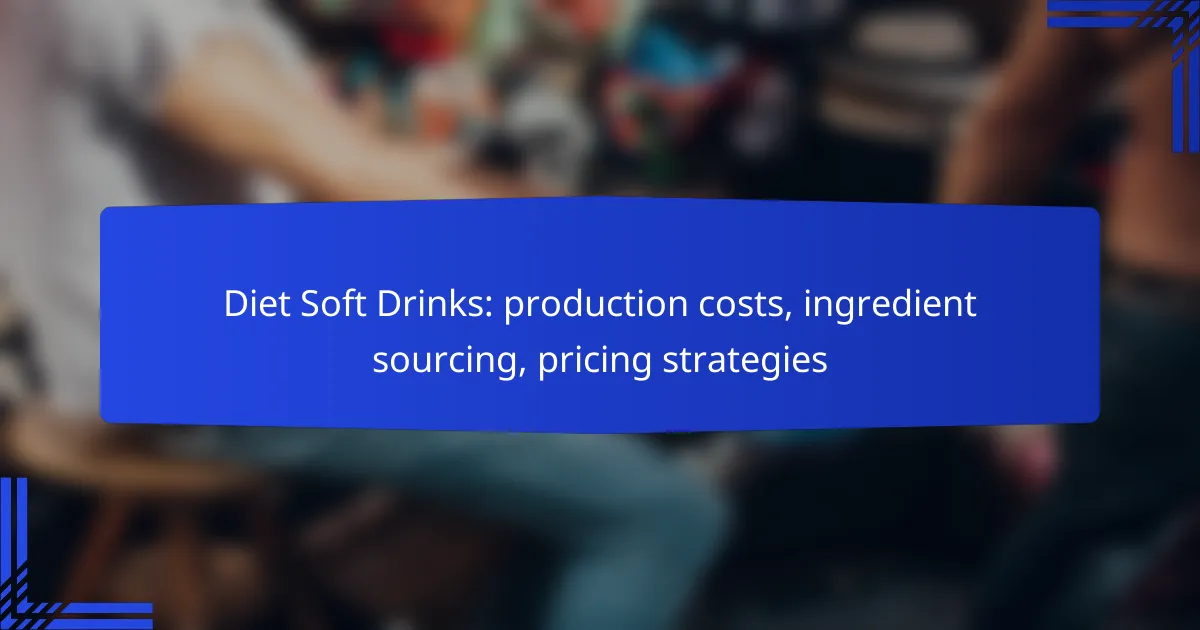Diet soft drinks are produced with careful consideration of various factors that influence production costs, including raw materials, labor, and packaging. The sourcing of ingredients involves a mix of agricultural and synthetic methods, ensuring that key components like sweeteners and flavorings meet quality standards. To remain competitive in the market, manufacturers employ diverse pricing strategies that cater to consumer preferences and market dynamics.

What are the production costs of diet soft drinks in Australia?
The production costs of diet soft drinks in Australia encompass various factors, including raw materials, labor, manufacturing overhead, distribution, and packaging. Understanding these costs is crucial for manufacturers to set competitive pricing and maintain profitability.
Raw material costs
Raw material costs for diet soft drinks primarily include sweeteners, flavorings, and carbonated water. In Australia, artificial sweeteners like aspartame and sucralose are commonly used, and their prices can fluctuate based on global supply and demand. Typically, raw material costs can account for a significant portion of the overall production expenses, often ranging from 30% to 50% of total costs.
Additionally, sourcing high-quality ingredients may lead to higher costs, but it can enhance product appeal and consumer satisfaction. Manufacturers often negotiate bulk purchasing agreements to mitigate these expenses.
Labor expenses
Labor expenses in the production of diet soft drinks include wages for factory workers, quality control personnel, and administrative staff. In Australia, the minimum wage is relatively high compared to other countries, which can increase overall labor costs. These expenses can represent around 15% to 25% of total production costs.
Investing in training and efficient labor practices can improve productivity and reduce waste, ultimately lowering labor costs in the long run.
Manufacturing overhead
Manufacturing overhead encompasses costs related to facility maintenance, equipment depreciation, and utilities. In Australia, these overhead costs can vary widely based on the scale of production and location. Generally, overhead can account for 10% to 20% of total production costs.
To manage these expenses, manufacturers should regularly assess their operational efficiency and consider investing in energy-efficient equipment to reduce utility costs.
Distribution costs
Distribution costs involve transporting finished products to retailers and wholesalers. In Australia, these costs can be influenced by fuel prices, distance to market, and logistics efficiency. Distribution typically represents about 10% to 15% of total production costs.
Utilizing a well-planned distribution network and optimizing delivery routes can help minimize these expenses, allowing for better pricing strategies.
Packaging expenses
Packaging expenses include the costs of bottles, labels, and cartons used for diet soft drinks. In Australia, sustainable packaging options are becoming more popular, often leading to higher upfront costs but potential long-term savings and consumer loyalty. Packaging can account for 15% to 25% of total production costs.
Manufacturers should evaluate packaging materials and designs that balance cost, sustainability, and consumer appeal to optimize their packaging expenses.

How are ingredients sourced for diet soft drinks?
Ingredients for diet soft drinks are sourced through a combination of agricultural production, chemical synthesis, and supplier partnerships. Key components include natural sweeteners, flavoring agents, and carbonation sources, each with specific sourcing considerations and trade-offs.
Natural sweeteners sourcing
Natural sweeteners, such as stevia and monk fruit extract, are typically sourced from agricultural producers who cultivate these plants. The sourcing process involves ensuring that suppliers adhere to quality standards and sustainability practices, which can vary by region.
For example, stevia is primarily grown in countries like China and Paraguay, where climate conditions are favorable. Buyers often negotiate contracts that secure stable prices, which can fluctuate based on crop yields and demand.
Flavoring agents procurement
Flavoring agents for diet soft drinks are usually obtained from specialized manufacturers who extract flavors from natural sources or create synthetic alternatives. The procurement process requires careful evaluation of flavor profiles and regulatory compliance to ensure safety and quality.
Companies often engage in long-term partnerships with flavor houses to develop unique blends that appeal to consumers. This can involve extensive testing and adjustments to meet taste preferences while maintaining low-calorie counts.
Carbonation sources
Carbonation in diet soft drinks is primarily achieved through the use of carbon dioxide, which is sourced from industrial gas suppliers. The sourcing of CO2 can involve considerations related to purity and environmental impact, as some suppliers utilize by-products from other processes.
Producers may choose between food-grade CO2, which meets stringent safety standards, and other sources that may not be suitable for consumption. Ensuring a reliable supply chain for carbonation is crucial, especially during peak production periods.

What pricing strategies are used for diet soft drinks?
Diet soft drinks utilize various pricing strategies to remain competitive and appealing to consumers. These strategies include competitive pricing analysis, value-based pricing, and promotional pricing tactics, each tailored to market conditions and consumer preferences.
Competitive pricing analysis
Competitive pricing analysis involves setting prices based on the prices of similar products offered by competitors. Companies often monitor the pricing of leading diet soft drink brands to ensure their products are priced attractively while maintaining profitability.
For instance, if a popular diet soda is priced at around $1.50 for a 12-pack, a brand may choose to price its own product slightly lower to entice price-sensitive consumers. This strategy helps brands position themselves effectively in a crowded market.
Value-based pricing
Value-based pricing focuses on the perceived value of the diet soft drink to consumers rather than just production costs. Brands assess how much customers are willing to pay based on taste, health benefits, and brand reputation.
For example, a diet soft drink that is marketed as having natural sweeteners may command a higher price due to its perceived health benefits. This strategy requires thorough market research to understand consumer preferences and willingness to pay.
Promotional pricing tactics
Promotional pricing tactics involve temporary price reductions or special offers to boost sales and attract new customers. Common methods include discounts, buy-one-get-one-free deals, or limited-time offers.
For instance, a brand may offer a 20% discount on diet soft drinks during summer months to increase sales volume. These tactics can create urgency and encourage trial among consumers who may be hesitant to purchase at full price.

What are the market trends for diet soft drinks in Australia?
The market for diet soft drinks in Australia is evolving, driven by changing consumer preferences and health considerations. As more Australians seek healthier options, brands are adapting their offerings to meet these demands.
Health-conscious consumer preferences
Health-conscious consumers in Australia are increasingly opting for diet soft drinks that align with their wellness goals. This trend is reflected in a growing demand for beverages that are low in calories and sugar-free, appealing to those monitoring their weight or managing health conditions.
Brands are responding by reformulating their products to include fewer artificial ingredients and more natural flavors. This shift not only caters to health-focused individuals but also attracts a wider audience looking for guilt-free indulgence.
Shift towards natural ingredients
There is a notable shift in the Australian diet soft drink market towards natural ingredients. Consumers are becoming more aware of the potential health impacts of artificial sweeteners and preservatives, leading to a preference for drinks made with natural sweeteners like stevia or monk fruit.
This trend is prompting manufacturers to reformulate their products, ensuring they meet consumer expectations for cleaner labels. Brands that successfully incorporate natural ingredients often see a boost in sales and customer loyalty.
Emerging brands and competition
The diet soft drink market in Australia is witnessing an influx of emerging brands that challenge established players. These new entrants often focus on niche markets, such as organic or functional beverages, which cater to specific consumer needs.
As competition intensifies, established brands are compelled to innovate and enhance their product lines. This dynamic environment encourages continuous improvement in taste, packaging, and marketing strategies to capture the attention of health-conscious consumers.

What are the regulatory considerations for diet soft drinks?
Diet soft drinks must adhere to various regulatory considerations that ensure consumer safety and accurate product representation. Key areas include food safety regulations and labeling requirements, which are essential for compliance in the beverage industry.
Food safety regulations
Food safety regulations for diet soft drinks focus on the safety of ingredients and the manufacturing process. Manufacturers must comply with standards set by food safety authorities, such as the FDA in the United States or EFSA in Europe, which dictate permissible ingredients and safety protocols during production.
Regular inspections and quality control measures are vital to ensure that diet soft drinks meet safety standards. This includes monitoring for contaminants and ensuring that production facilities maintain hygienic conditions. Failure to comply can lead to product recalls and legal penalties.
Labeling requirements
Labeling requirements for diet soft drinks are designed to provide consumers with clear and accurate information. Labels must include nutritional information, ingredient lists, and any relevant health claims, which must be substantiated by scientific evidence.
In many regions, specific regulations dictate how artificial sweeteners and other additives are labeled. For example, in the EU, products containing certain sweeteners must indicate their presence on the label, while in the U.S., the FDA requires that any health claims be backed by research. Ensuring compliance with these labeling requirements is crucial for market access and consumer trust.

How do diet soft drinks compare to regular soft drinks?
Diet soft drinks are formulated to provide a similar taste to regular soft drinks but contain little to no calories. The primary difference lies in the use of artificial sweeteners instead of sugar, which significantly alters their production costs and pricing strategies.
Production costs of diet soft drinks
The production costs of diet soft drinks generally differ from regular soft drinks due to the ingredients used. Artificial sweeteners, such as aspartame or sucralose, can be more expensive than sugar, but they require smaller quantities to achieve the desired sweetness. This can lead to lower overall sugar costs, although the initial investment in sourcing and quality control may be higher.
Additionally, the manufacturing process for diet soft drinks may involve more stringent quality checks to ensure the safety and efficacy of artificial ingredients. This can increase operational costs, but these expenses are often offset by the higher retail prices that diet drinks command in the market.
Ingredient sourcing for diet soft drinks
Ingredient sourcing for diet soft drinks focuses on obtaining high-quality artificial sweeteners and flavorings. Manufacturers often work with specialized suppliers to ensure that the sweeteners meet regulatory standards and consumer preferences. Sourcing can vary by region, with some countries having stricter regulations on the use of certain sweeteners.
In the United States, for example, the FDA regulates artificial sweeteners, which can impact sourcing decisions. In contrast, European markets may have different approved substances, affecting ingredient availability and cost. Companies must navigate these regulations while maintaining a consistent flavor profile across different markets.
Pricing strategies for diet soft drinks
Pricing strategies for diet soft drinks often reflect their production costs and market positioning. Typically, diet drinks are priced higher than regular soft drinks due to the perceived health benefits and the premium associated with artificial sweeteners. Brands may also employ promotional pricing strategies to attract health-conscious consumers.
Furthermore, companies may use tiered pricing, offering various diet options at different price points to cater to diverse consumer segments. For instance, a brand might offer a standard diet option alongside a premium version with natural sweeteners, allowing consumers to choose based on their preferences and budget.
